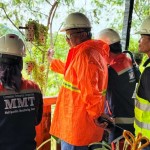Pilot plants commissioned in China and the PhilippinesEstablishment of a nickel processing plant to further drive the Philippines’ leadership in nickel production
Manila, Philippines / June 2013 – TVI Pacific Inc. (TSX: TVI) (OTCQX: TVIPF) announced today that based on positive bench-scale test work results at the Agata Nickel Processing Project, it has commissioned and commenced operation of pilot-plant testing, which will further define the technological parameters to be used in producing a Bankable Feasibility Study with the goal of building a commercial processing plant.
“We are extremely pleased with the results achieved,” said TVI Pacific Inc. Chairman and CEO Cliff M. James. The positive test work on nickel laterite ore from the Agusan mine site confirms that the Agata ore is highly amenable to acid leaching – a highly cost-effective process utilizing sulphuric acid to recover nickel from the ore. Tests achieved a high rate of nickel extraction at a low consumption of acid.
TVI is further developing leaching process technology to attain increased metal production, lower operating costs and a significantly low impact to the environment. This development potentially ranks the company among the lower cost producers and positions it as a prudent financial manager.
“The process being developed could position the proposed Agata nickel processing plant amongst the lower cost producers,” James added.
The newly established Agata Mining Ventures Inc. – a joint venture with Mindoro Resources Ltd. (MRL) – operates the project located in Agusan del Norte province in the Surigao mining region, which is a major nickel-producing region providing ore to processing plants in Australia, China, Korea and Japan.
In 2012, TVI and MRL signed four joint venture agreements relating to the Agata and Pan de Azucar mining projects located in the islands of Mindanao and Panay, respectively. TVI has the ability to earn a 60% interest and will act as operator of the projects. The Agata Project bears a robust foundation for moving forward, initially with high iron and limestone direct shipping ore.
With plans to construct a nickel processing plant in the medium-term, the Agata project is also expected to further drive the Philippines’ leadership as the world’s largest producer of nickel.
Positive test results
Approximately one ton of ore was sent to the Beijing General Research Institute of Mining and Metallurgy for bench-scale tests to confirm and optimize the optimal circuit configuration and validate the leaching process currently developed by TVI.
A team of three TVI metallurgists were seconded to the institute for the duration of the test work while the company also set-up a similar test laboratory in Manila. Tests conducted in Beijing conclusively validated the company’s initial findings that the Agata ore is highly amenable to acid leaching. Similarly, tests performed by both the institute and TVI yielded consistent results.
To date, more than 70 leach tests have been conducted with an overall nickel extraction rate of 94 percent at a relatively low acid consumption rate of 650 kilograms per ton of ore. This translates to an encouraging utilization efficiency of 49 tons of acid per ton of nickel produced for ore grades containing 1.5% nickel.
Pilot Plants established in China and the Philippines
Ongoing pilot plant tests in China are conducted on a larger scale (compared to bench-scale) in order to simulate actual processing plant operations and conditions. Approximately 12 tons of ore were sent to Beijing in order to continuously operate a pilot plant. Leaching commenced on May 13, 2013 to test high (1.5%) and medium (1.3%) grades of ore.
Pregnant leach solution, which contains dissolved valuable metals, from Beijing will then be shipped to the TVI downstream nickel recovery pilot plant in Agusan. The plant will be commissioned this month in order to be operational by July 2013. Meantime, tests are expected to be completed during in the third quarter of 2013.
Approximately 30 tons of ore were mined from various test pits in the Agusan mine site then blended and loaded into sealed drums to preserve moisture. Test pits were carefully selected from the available drill hole data to accurately reflect the ore.
*******
Process Description
The process involves the treatment of higher Ni grade ore (>1.3% Ni). Much of the high iron (Fe) grade limonite will be directly shipped as part of a direct shipment of ore operation (DSO). Therefore, the ore feed to the process plant is depleted of limonite. In addition, the higher grade Ni is associated mainly with the saprolite ore (which occurs beneath the limonite in the ore profile) – therefore, once the higher grade ore is considered, the ratio of limonite: saprolite that will be fed to the process plant is approximately 8% limonite:92% saprolite.
The process consists of separating the ore into a high Fe, low magnesium (Mg) fraction to feed the primary leaching stage and a low Fe, high Mg fraction, to feed the secondary leaching stage. Leaching is conducted in 2 stages to minimize acid consumption, as well as clean the pregnant leach solution (PLS) of Fe.
PLS is recovered by a counter current decantation (CCD) circuit and then further refined using ion exchange (IX), and finally precipitated and filtered to produce a nickel hydroxide product (NHP) of 53% Ni content. This NHP is a versatile product since it is a refined intermediate product, and therefore, due to its purity, it is easily refined into Ni metal by potential off-takers.
Key Process Information
- Ore type: Ni grade >1.3%; 8% limonite, 92% saprolite
- Ore feed rate: 550,000 dtpa
- Leach Ni extraction: 94%
- Leach H2SO4 consumption: 650 kg/t ore
- Overall Ni recovery: 92%
- Ni product: NHP; 53% Ni; 7,000 – 7,500 t contained Ni pa.
Qualified Person
Yulo Perez, Chief Operations Officer of TVI Resource Development (Phils.), Inc. (TVIRD), Fellow AusIMM, is the qualified person under NI 43-101 who has approved the scientific and technical information in this news release.
Download PDF
Download Word Document



